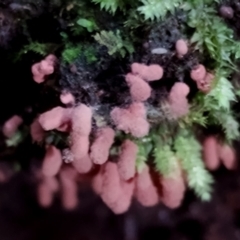Arcyria denudata
Arcyria denudata
Arcyria denudata often appears with having fresh brick red sporocarps on stalks 1.5-2.5 mm long and with capillitial plumes expanding up to 10 mm in length. This form tends to appear in large colonies; some specimens estimated to consist of more than 5000 sporocarps.
Sporocysts cylindrical, ovoid, mostly gregarious, characterized by ellipsoid sporothecae 1.5–5 mm in length, 0.5–1.0 mm wide on a tiny stalk that is not readily apparent, pinkish red to brick red but weathering to brown.
Peridium fugacious except for prominent funnel to cup-shaped calyculus above the darker stalk.
The capillitium is ornamented with relatively distant half-rings and rings with the capillitium firmly attached to whole inner surface of calyculus and retaining its shape after dehiscence
Stalk less than one-fourth the total height, the same colour as the rest of the fruiting body
Spores red or reddish brown in mass. Spores 6-8 µm diam. minutely, pale-warted and with scattered larger wartlets.
Habitat: On decaying wood or bark in broadleaf forests; usually occurring in large groups.
Because of their bright red colour, the fruiting bodies of Arcyria denudata are easily noticed in nature. Large fruitings can be 15 cm or more in total extent.
Biological Role: The vegetative stage (called a plasmodium) in the life cycle of this organism feeds upon the bacteria associated with decaying plant material.
Arcyria denudata is listed in the following regions:
Species information
- Arcyria denudata Scientific name
- Common name
- Not Sensitive
- Local native
- Non-invasive or negligible
- Machine learning
Location information
-
Maps
Bodalla State Forest








